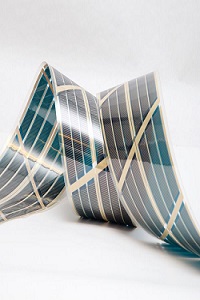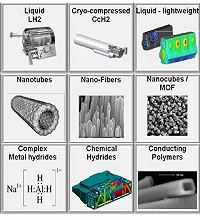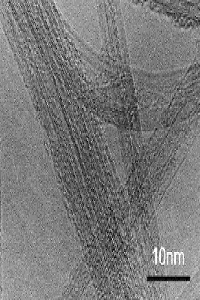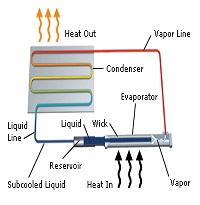The properties of fullerenes and carbon nanotubes have caused researchers and companies to consider using them in many different fields. The following descriptions of their applications introduces several of these uses. At Intellectual Alliance Inc we proud to be involved to development of some applications, producing products for a market on the base of own carbon nanoproducts.
|
Lubrication. |
||
|
As tested and evaluated presence of nanoscale fullerenes in any lubricants improves significantly the friction and antiwear characteristics of oils, greases and other liquids. This is presumably because fullerene nanoparticles, which were inserted between the friction surfaces, simultaneously preventing direct metal surface contacts, acting as myriad microscopic bearing balls, spreaded within lubrication liquid. Fullerenes have very high strength bonds between the carbons, the same strength as in a diamond. And because of those bonds they are very temperature resistant and will not break down under high heat and pressure like petroleum based lubricants can. |
 |
|
|
Flexible Solar Panels. |
||
|
New type of solar cells was introduced recently. This is organic photovoltaic (OPV). The term organic relates to the fact that carbon-based materials are at the heart of these devices, rather than silicon. Organic photovoltaics can be made of compounds that are dissolved in ink so they can be printed on thin rolls of plastic. They can bend or curve around structures or even be incorporated into clothing. Solar inks are typically comprised of metal salts suspended in a polymer fullerene blend. The ink consist of a photoactive layer made up of p-type polymer and n-type fullerene, a hole transport ink, and can be combined with a cathode and an anode suspended on a substrate. Since the system can be applied in layered coatings, it is possible to use existing ink jet printer technologies to print working solar cells onto plastic substrates in 0.2 micrometer thickness to absorb the sun’s energy. Using this incredibly thin layering one kilogram of the polymer can be used to print a solar cell the size of a football field. The resulting material is lightweight, flexible, and semi-transparent. The main advantage of using solar inks is their cost of production. Since printed solar cells can be manufactured at atmospheric pressure and ambient temperature they are cheaper to produce. In 2018 efficiency of organic photovoltaic was reached 17%. This is important because according to estimates, with this efficiency and a 20 year lifetime, organic solar cells could produce electricity at a cost of less than 7 cents per kilowatt-hour. Organic solar cells ideally suited to power mobile applications - camping gear, smart wearables or phone chargers, just to name a few - which have been only insufficiently addressed by classical solar cell technologies such as silicon. |
 |
|
|
Supercapacitors. |
||
|
Current research and development on energy-storage devices have been mainly focused on supercapacitors, lithium-ion batteries and other related batteries. Compared with batteries, supercapacitors possess higher power density, longer cyclic stability, higher Coulombic efficiency and shorter period for full charge–discharge cycles. Thus, supercapacitors, particularly those based on carbon CNTs, graphene and mesoporous carbon electrodes, have gained increasing popularity as one of the most important energy-storage devices. The prepared C60/graphene composite was employed as electrode in supercapacitors. It was found that the specific capacitance of C60/graphene composite reached 135.36 F g−1 at the current density of 1 A g−1 compared to pure graphene as electrode (101.88 F g−1). This composite material was also exhibited a remarkable retention rate of 92.35% after 1000 charge/discharge cycles. This result showed that the composite was a promising material for supercapacitor electrode. |
 |
|
|
Hydrogen Gas Storage. |
||
|
Due to its unique molecular structure, fullerene is the only form of carbon, which potentially can be chemically hydrogenated and de-hydrogenated reversibly. When fullerenes are hydrogenated, the C=C double bonds become CC single bonds and C-H bonds. The bond strength of single C-C bonds is 83 kcal/mole, and theoretical calculations show that the bond strength of the hydrogenated C-H bond is 68 kcal/mole. This means that for fullerene hydrides, the H-C bond is appreciably weaker that C-C bonds. Therefore, when heat is applied to fullerene hydrides, the H-C bonds will break before the C-C bonds, and the fullerene structure should be preserved. The considerably lower heat of formation for C60H36 indicates that C60H36 as a molecule is thermally more stable than C60. Therefore, hydrogenation of C60 is thermodynamically favored and can be accomplished under the right chemical conditions. There are about 100 different molecules of hydrogenated fullerenes, which could be obtained with different temperatures, pressures and chemical reactions applied. All these researches and experiments show promising results to use safe hydrogen storage. |
 |
|
|
Cosmetics. |
||
|
As cosmetic technology advances, there is an increasing need to use new active ingredients in the development of cosmetic products. In the last few years application of fullerene C(60) and its derivates in cosmetics has been intensively tested. Fullerenes display a wide range of biological activities. Potent scavenging capacities against radical oxygen species (ROS) and excellent potential as biological antioxidants made fullerenes suitable active compounds in the preparation of skin rejuvenation cosmetic formulations. There are currently published evidences on biological activities of fullerenes relevant for their cosmetic use and examples of published patents to illustrate application of fullerenes in cosmetic technology. |
 |
|
|
Medicine. |
||
|
One of the most important and impressive uses of fullerene is medicine. Fullerenes are active molecules, which can be used as an antioxidant because it can easily react with radicals due to the high affinity of the electron. At the same time, fullerene is used as an anti-aging and anti-damage agent in the cosmetic sector. Fullerenes are used as antiviral agents. This use is provided by its unique molecular structure, antioxidant effect and biological compatibility. Some fullerenes can form conjugates with proteins and DNA. This situation is thought to help the development of anti-cancer treatments. Fullerene molecule can be used in drug delivery area. The surface of fullerene is covered with a chemotherapeutic agent. This agent finds the cancer cell and is transported directly there. It has also been shown that the fullerene reagent forms a protective layer on the DNA and extends the DNA life of the endosomes. May be used for osteoporosis treatment because of its preferential localization. |
 |
|
|
Concrete. |
||
|
There were numerous researches and studies of durability of concrete reinforced with different types of multi-walled carbon nanotubes (CNTs). Carbon nanotubes (CNTs) are a virtually ideal reinforcing agent due to extremely high aspect ratios and ultra high strengths. It is evident from researches that utilization of CNT in producing new cement-based composite materials has a great benefit. Consequently, possible practical application of CNT reinforced cementitious composites has immense prospect in the field of applied nanotechnology within construction industry. Several repair, retrofit, and strengthening techniques are currently available to enhance the integrity and durability of concrete structures with cracks and spalling. In addition to their high strength and elasticity, CNTs have extremely high aspect ratios, with values typically higher than 1000 : 1 and reaching as high as 2,500,000 : 1. Results show the benefits of CNTs contribution to the enhancement of mechanical and durability properties of concrete, regardless of the type of CNTs and w/c ratio. The incorporation of 0.05–0.1% CNTs, by weight of cement, improved mechanical strength and durability properties up to 21% and 25%, respectively. The incorporation of CNTs was more effective when concrete was subjected to cracking conditions. In general, the best performance was found in concrete with higher amounts of CNTs of lower aspect ratio. There are several properties of concrete required improvements, especially for long term exploitation. These are cracking, damages from freeze/thaw effects, damages from chemicals and salts, flaking and peeling, pitting, spalling and others. There is also one major obstacle which scientists and researches have to overcome, mixing technique of cementitious materials with CNTs to provide identical proportions. At Intellectual Alliance Inc. we propose own solution for this problem in developing proprietary concrete reinforce method. |
 |
|
|
Coolants. |
||
|
During last years multiwall carbon nanotube suspensions (MWCNT nanofluids) were tested in an intertube falling-film flow to explore the nanofluid effects on heat transfer characteristics. Water-based and ethylene–glycol-based nanofluids are prepared at concentrations of 0 to 0.24 vol%. Thermal conductivity and viscosity of these nanofluids was measured. Falling-film heat transfer behavior of these nanofluids was also investigated and the results are compared to those of the base fluids. Based on the same liquid feeding flow rate, it is observed that the heat transfer coefficients of the ethylene–glycol-based nanofluids increases as the MWCNT concentration increases. When comparing the heat transfer coefficient based on the same Reynolds number, up to 20% or higher heat transfer enhancement can be observed for ethylene–glycol based nanofluids. The science waits for numerous experiments, calculations and conclusions for different heat transferring systems to create viable and feasible solution. |
 |
|
|
Perspective applications. |
||
|
Fullerene Strengthening/Hardening of Metals. Fullerenes offer unique opportunities to harden metals and alloys without seriously compromising their ambient temperature ductility. This is due to the unique characteristics of fullerenes, namely their small size and high reactivity, which enable the dispersion strengthening of metallic matrices with carbide particles that result from in-situ interactions between fullerenes and metals. Fullerene as Precursor to Diamond Fullerenes have proven to be an excellent precursor to diamond. This can be attributed in part to the curved structure of fullerenes, which possess a partial sp' (diamond) bonding configuration, as opposed to graphite, which is planar. Optical Application of Fullerene. Optical limiting refers to a decrease in transmittance of a material with increased incident light intensity. The phenomenon of optical limiting has a significant potential for applications in eye and sensor protection from intense sources of light. Based on the optical limiting properties of fullerenes, one can make an optical limiter, which allows all light below an activation threshold to pass and maintains the transmitted light at a constant level below the damage threshold for the eye or the sensor. Fullerenes Based Sensors. Fullerene-based interdigitated capacitors (IDCs) recently have been developed to explore sensor applications. This novel solid-state sensor design is based on the electron accepting properties of fullerene films and the changes that occur when planar molecules interact with the film surface. Fullerenes as Molecular Wires. Recent experiments have documented electron transport through single molecules. Under certain experimental conditions molecular conduction through a single molecule rather than through an ensemble of molecules is guarantee. This phenomenon is possible due the high electron affinity of fullerenes. And many other known and unknown unlimited applications. |
||